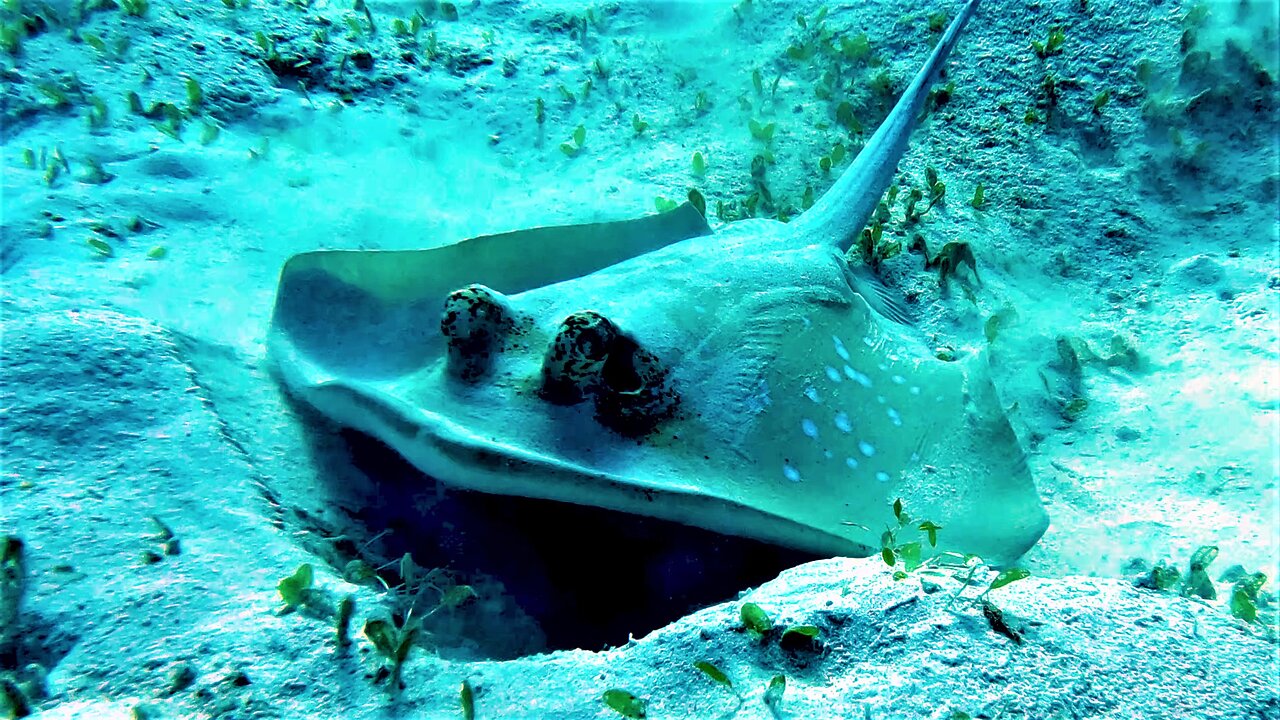Premium Only Content

Spotted ribbontail stingray eats animals hidden in the sand
Stingrays are highly intelligent and well adapted animals that live in most oceans around the world. They are beautiful to watch in motion as they glide along the ocean floor. Their flattened bodies are perfect for allowing them to skim over sand and debris, hunting for crustaceans, fish, and mollusks buried beneath. Their wings are used to beat the sand to uncover the animals, allowing them to be sucked into the stingray's mouth for consumption. A stingray's snout has pores filled with a gelatinous substance that detects the electrical impulses of prey, even those hidden or buried under solid material.
The jaws of the stingray are powerful, with flattened teeth that can crush shells to eat the animals sheltered within. Prey is inhaled into the mouth, crushed and swallowed. The sand and shells are expelled and the stingray moves on to the next meal.
The stingray has a special adaptation for breathing as well. It inhales water, but not through its mouth. It has spiracles located behind the eyes, through which water is sucked in, forced over the gills and expelled. This makes it possible for the stingray to breath, even when its body is buried in sand. The spiracles and eyes remain uncovered as the stingray benefits from the camouflage of a sanding covering.
As with many of the ocean's animals, a special adaptation creates a defense from predators. In most species of stingray, the tail is equipped with 1-3 sharp barbs. If a stingray is threatened or is stepped on, the barb can deliver a painful injury. The barbs often break off and remain in the wound. Although the wound itself is rarely fatal, the barb also has a venom that causes pain, and slows blood circulation. Stingrays are not aggressive and will very rarely attack humans or other animals, but accidents due to being accidentally stepped on in areas with swimmers are one of the leading causes of injuries from fish.
The stingray is a fish, and part of the shark family. They are cartilaginous, meaning that they don't have bones. Stingrays have the highest ratio of brain size to body mass of any fish and are thought to be the smartest of the fish. They demonstrate and ability to remember, learn, and communicate which exceeds what was previously believed.
Stingrays are still very mysterious creatures and we don't yet understand them fully. As we gain understanding of their roles in the health of the ocean and our planet, we will also gain insight that will help us protect them for the future.
-
 1:26
1:26
WildCreatures
1 month ago $5.94 earnedCow fearlessly grazes in crocodile-infested wetland
59K9 -
 1:03:40
1:03:40
TheCrucible
8 hours agoThe Extravaganza! EP: 56 with Geust co-host Rob Noerr (10/20/25)
20.9K12 -
 2:03:29
2:03:29
Inverted World Live
5 hours agoNASA Says Earth Has Two Moons, 3I/Atlas Hiding Behind The Sun | Ep. 126
8 -
 3:10:08
3:10:08
TimcastIRL
5 hours agoNO KINGS Protester Yells KILL DHS, Liberal Tries KILLING Trump Supporter At His Home | Timcast IRL
89 -
 1:00:31
1:00:31
FreshandFit
7 hours agoWe Are In A Recession...Do This Now!
2.22K21 -
 LIVE
LIVE
Side Scrollers Podcast
1 day ago🔴SIDE SCROLLERS FUND-A-THON🔴DAY 1🔴100% REVENUE HELPS CHANGE CULTURE!
1,270 watching -
 3:03:39
3:03:39
Barry Cunningham
6 hours agoPRESIDENT TRUMP HAS A MAJOR WIN AND HIS TEAM IS ABSOLUTELY UNLEASHED!
67931 -
 58:59
58:59
Flyover Conservatives
23 hours agoThe Agenda Behind No Kings — They Lied. They Funded It.; Silver Explosion FAR from Over, PhD Explains What’s Next and Why! - Dr. Kirk Elliott | FOC Show
4.53K4 -
 1:55:03
1:55:03
We Like Shooting
16 hours agoWe Like Shooting 633 (Gun Podcast)
106 -
 1:32:29
1:32:29
Glenn Greenwald
8 hours agoNo Kings Protests: A Partisan Pro-DNC Circus; The Trump Admin's Escalating Strikes on "Drug Boats" and Militarization of the Caribbean | SYSTEM UPDATE #534
17.4K68